

Current status of herbarium specimens and geographical distribution of bamboo (Gramineae: Bambsusoideae) in China. Global Change Biology: Museum Specimens Are More Than Meet the Eye. Global Change Biology: Museum Specimens Are More Than Meet the Eye. What Victorian-era seaweed pressings reveal about our changing seas. On his first day as the new science director for the Monterey Bay Aquarium in California in 2016, a giant blue storage locker caught Kyle Van Houtan’s eye.
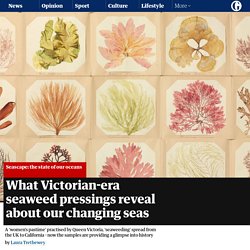
The locker was obscured by a dead ficus plant and looked as if no one had opened it for years. But the label on it intrigued him: Herbarium. He opened it and inside found hundreds of stacked manila envelopes. Each one contained a single piece of seaweed, pressed and preserved on white paper. The collection demonstrated a curator’s attention to detail, with neat labels in tidy handwriting that documented every seaweed’s origin and collector. Awesome talk by @Missing_Rectrix on effect of environmental change on pollen received on plant stigmas over the past 100 years...using @CarnegieMNH #herbarium specimens! And only her first rotation in #ashmanlab, stay tuned as her dissertation research pr.
Phycological Herbaria as a Useful Tool to Monitor Long-Term Changes of Macroalgae Diversity: Some Case Studies from the Mediterranean Sea. 3.1.
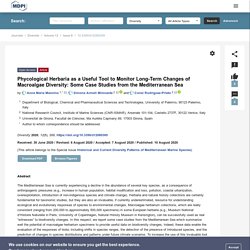
Overview of European Phycological Collections According to the Index Herbariorum, 688 herbaria are present in 33 European countries (Figure 1), with France, the UK, and Germany hosting the highest number of herbarium specimens (25.96, 22.31, and 22.16 million specimens, respectively) [27]. Herbaria macroalgae as a proxy for historical upwelling trends in Central California. 1.

Introduction Long-term environmental records are critical for understanding natural variability, establishing informed ecological baselines and designing effective management strategies [1,2]. Coastal environments have seen dramatic ecological changes over the last 150 years [3–5]; however, much of this period is scientifically undocumented. Marine organisms may fill important data gaps and extend time series, as numerous and diverse taxa archive environmental conditions within their tissues [6–11], recording an ‘ocean memory' [12]. As a result, natural history repositories of marine algae, foraminifera, corals, birds, reptiles and other taxa may facilitate reconstruction of historical environmental conditions to complement and extend instrument records.
Phenology. Weeds. Environmental Change. Using herbaria to study global environmental change - Lang - 2019. Introduction Global environmental change is one of the major challenges of the 20th and 21st centuries. It has been evident since the age of industrialization in the late 18th century – sometimes also referred to as the advent of the anthropocene – and has continuously gained momentum (Fig. 1a; Steffen et al., 2011; Hamilton, 2016). Biologists study global change for its broad ecological impact, and its negative effects on biodiversity. Also, as it represents an unplanned, long‐term and large‐scale experiment, studying global change can promote understanding of fundamental processes such as rapid adaptation. Experimental approaches to study these topics are usually locally focused, and limited to a duration of a few decades (Leuzinger et al., 2011).
Using iNaturalist with specimens: Heberling. Digitized plant collection to answer how living in a megalopolis affects flora. Megalopolis: Centuries-old plant collections answer questions on impact of urbanization. August 24, 2018 | 04:17 PM Susan Phillips tells stories about the consequences of political decisions on people's every day lives.
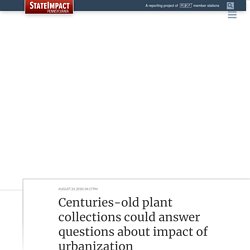
She has worked as a reporter for WHYY since 2004. Susan's coverage of the 2008 Presidential election resulted in a story on the front page of the New York Times. Conservation Biology. Herbarium Collections as Tools for Conservation Biology. Contrasting spatial, temporal and environmental patterns in observation and specimen based species occurrence data. Abstract Species occurrence data records the location and time of an encounter with a species, and is valuable for many aspects of ecological and evolutionary analyses.
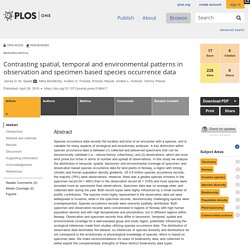
A key distinction within species occurrence data is between (1) collected and preserved specimens that can be taxonomically validated (i.e., natural history collections), and (2) observations, which are more error prone but richer in terms of number and spread of observations. In this study we analyse the distribution in temporal, spatial, taxonomic and environmental coverage of specimen- and observation based species occurrence data for land plants in Norway, a region with strong climatic and human population density gradients. Of 4.8 million species occurrence records, the majority (78%) were observations. Century-old botany records may hold key to monarch butterfly survival. Naturalists' records dating back more than 100 years may be instrumental in determining the fate of the monarch butterfly in the 21st century.
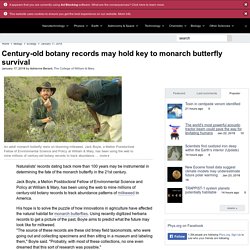
Jack Boyle, a Mellon Postdoctoral Fellow of Environmental Science and Policy at William & Mary, has been using the web to mine millions of century-old botany records to track abundance patterns of milkweed in America. His hope is to solve the puzzle of how innovations in agriculture have affected the natural habitat for monarch butterflies. Using recently digitized herbaria records to get a picture of the past, Boyle aims to predict what the future may look like for milkweed. "The source of these records are these old timey field taxonomists, who were going out and collecting specimens and then sitting in a museum and labeling them," Boyle said. Particulate Matter Deposited on Platanus acerifolia Leaves. † Institute of Agro Environmental and Forest Biology, National Research Council (IBAF−CNR), Via Marconi 2, Porano 05010, & Via Castellino 111, Napoli 80131, Italy ‡ Laboratory of Environmental and Urban Ecology, Department of Bioscience Engineering, University of Antwerp, Groenenborgerlaan 171, Antwerp 2020, Belgium § Center for Ecological-Noosphere Studies, National Academy of Sciences of Armenia, Abovyan 68, Yerevan 0025, Armenia ∥ Ecotoxicology of Air Pollution, CIEMAT, Avda.
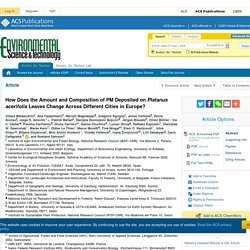
Complutense 22, edif. 70, Madrid 28040, Spain. Fungal Collections: infer biogeographic, environmental, host structure in communities of endophytic fungi. The strengths and weaknesses of species distribution models in biome delimitation - Moonlight - - Global Ecology and Biogeography. Macroecology is the study of large‐scale patterns of biological diversity across space and time and the underlying community assembly processes that determine these patterns.
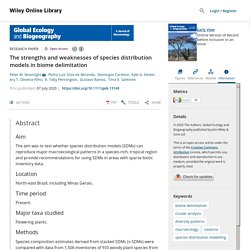
The description of macroecological patterns is of paramount importance in addressing the global, societal need for planet‐wide ecosystem models, which have the potential to transform our understanding of the biosphere (Purves et al., 2013; Socolar, Gilroy, Kunin, & Edwards, 2016). As a science, macroecology relies upon accurate and comprehensive data of species distributions through time and space. Distribution data for mammals, birds and amphibians are becoming increasingly available (Castro‐Insua, Gomez‐Rodrıguez, & Baselga, 2016; McKnight et al., 2007; Melo, Rangel, & Diniz‐Filho, 2009), but distribution data for most lineages in the tree of life are still poor (Scheffers, Joppa, Pimm, & Laurance, 2012).
This is known as the Wallacean shortfall. Can s‐SDMs be used to delimit biomes? Using Herbarium Specimens to Understand Patterns of Plant Diversity. The oldest specimens in the herbarium of the Royal Botanic Garden Edinburgh was collected in 1697, a little over 320 years ago.
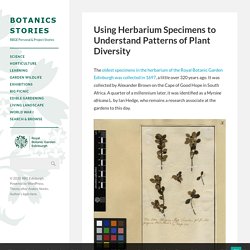
It was collected by Alexander Brown on the Cape of Good Hope in South Africa. A quarter of a millennium later, it was identified as a Myrsine africana L. by Ian Hedge, who remains a research associate at the gardens to this day. We do not know exactly why Alexander Brown made this herbarium specimen but what he effectively did was to make a data point. His collection, like every one of the three million specimens in the RBGE herbarium, is a record of a plant in space and time.
Vouchers in ecology.